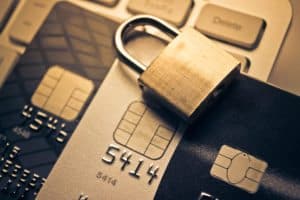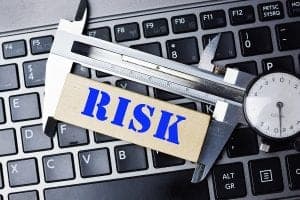If your small business has a merchant account, then you will need a merchant identification number in order to process your credit card payments. Keep on reading to find out more about MIDs.
Our content reflects the editorial opinions of our experts. While our site makes money through
referral partnerships, we only partner with companies that meet our standards for quality, as outlined in our independent
rating and scoring system.
A merchant ID (MID) is an important part of every credit card transaction your business processes. Not all merchants who accept credit cards have their own MID — sometimes simply called the merchant number — but those who work with a merchant account provider know it is required if they want to transfer money from their customers to their merchant accounts.
Do you own a small business that has a MID? Chances are good that you’re curious to know how you can find your MID, the role it plays in the credit card processing chain, and how it differs from other, similar terms.
Don’t have a merchant account yet? Check out the best payment processing companies for small businesses.
What Is A Merchant Identification Number (MID)?
Your business’s merchant ID is a unique code that your payment processor gives you. A merchant ID (or MID) is the code used to identify merchants while they process credit card payments. Merchants that accept card payments need a MID to have a cardholder’s payment sent to their merchant account.
Only businesses that have merchant accounts, though, have MIDs. If you use third-party payment processors like Square, Stripe, or PayPal, you won’t receive a MID. This begs the question, “How do I get a MID to process credit card payments in the first place?”
How Do You Get A MID For Payment Processing?
Your business obtains its MID when it begins working with an acquiring bank after opening a merchant account. Whether you want to work with an acquiring bank directly or indirectly with the help of a merchant services provider, you’ll need to complete a verification process to get your MID.
You’ll need to have your TIN (taxpayer identification number) and a list of your business’s principal owners to complete this verification process. Once it’s complete, your payment processor provides you with a unique MID it can use to identify you during your transactions with customer cardholders.
In the event you switch between merchant account providers, you’ll get a new MID shared by your new merchant account provider.
Do All Businesses Need A Merchant ID?
You do not necessarily need a merchant ID. Your MID is a unique account number that’s shared between you, your merchant account provider, your acquiring bank, and the service providers involved in the credit card processing chain. If you don’t have a merchant account, you do not need a MID.
You won’t be receiving an individual MID if you work with third-party processors or aggregators, either. Third-party processors, also sometimes called payment service providers, are hybrid entities that have one huge merchant account under their name, which means they can’t give you an individual account under your business name.
Third-party processors and aggregators identify card-accepting businesses like yours by issuing their own internal account numbers. Square, for instance, uses an email address to identify its merchants, while PayPal has its own account number system (which it also calls a merchant ID). Stripe and Shopify Payments have their own internal schemes with which they assign account numbers as well.
How A Merchant ID Works
To understand how MIDs work, let’s consider a simplified credit card payment process:
- After your customer pays with their credit card, you send your transaction information to your merchant account provider.
- Your account provider then passes your information on to an acquiring bank which, in turn, sends your info to an issuing bank.
- That issuing bank makes sure your customer has sufficient credit, after which it approves your payment and sends that approval back to the acquirer.
- The acquirer pays your merchant account provider, and your merchant account provider finally pays you.
Your MID comes into play when your merchant account provider sends a payment request and up until when your payment is sent back to you. In so many words, you can’t get paid without a MID; it’s the account number that identifies you while your payment request moves through third parties to an acquirer and then back to you.
Can A Merchant Have More Than One MID For Credit Card Processing?
Most merchants only have one main line of business and, therefore, only need one merchant category code to identify their business. However, merchants that have multiple lines of business may have more than one MID.
You can benefit from having multiple MIDs if:
- You need to distinguish between multiple brick-and-mortar locations at which you conduct business
- You maintain multiple revenue streams both online and in-person
- You want multiple accounting entities that can be individually analyzed for accounting purposes
Why You Should Know Your Merchant ID Number
Without a MID, you won’t be able to reach out to the different parties participating in the payment processing chain. These entities won’t be able to access your merchant file or assist you with payment processing issues if you don’t have your MID on hand.
Here are some common reasons why you should know your MID:
- It’s important to know your MID so as not to confuse it with other, similar terms. Some merchants, for instance, use gateway IDs for their payment gateways as part of their online credit card processing. Other merchants commonly confuse their MID with a merchant category code (MCC). An MCC is a unique code that’s separate from a MID and influences payment processing such as by determining interchange rates.
- Your merchant account provider is an independent contractor that works with an acquirer to set up your merchant account. In this case, you’ll need your MID if you ever need to contact the acquirer for support regarding chargeback issues.
- You become aware that bad actors use MIDs to execute illegal transactions. Some malicious third parties seek to compromise MIDs of small businesses like yours, so it’s important to keep your MID secure.
How To Look Up Your Merchant ID Number
You can look up your MID by:
- Checking the 15-digit code on your monthly merchant statement
- Accessing the online portal through which you manage your credit card processing account
- Checking the sticker or label that’s found on your credit card terminal
- Reading your processing/merchant agreement
- Looking at your account information page on your online payment processing apps
What Should You Do With Your Credit Card Processing MID Number?
We recommend that you keep your MID in a safe place that’s still easy to access, ideally somewhere close to your financial and legal documents. You may need to refer to your MID frequently if you ever need support with moving credit card payments from a customer’s account to your merchant account.
Unauthorized personnel should never have access to your MID since it’s tied to your transfer of money. Personnel whom you do authorize to access your MID should know how and where to find your MID quickly if they ever need to provide it to customer support in the event that payment issues arise.
Want to learn more about how credit card processing works? Read our comprehensive beginners’ guide to credit card processing.
Merchant Identification Number FAQs
How do I find my merchant ID?
You can find your MID by checking various sources such as your monthly merchant statement, the sticker or label on your credit card terminal, and your processing/merchant agreement.
Is a merchant ID the same as an EIN?
Your MID is a unique code your merchant account provider assigns you, while your EIN is an IRS-provided number that identifies your business for tax purposes.
How long is a merchant ID number?
The average length of a merchant ID is about 15 characters and may include numbers and letters.
Is a merchant ID the same as a tax ID?
Tax IDs such as an EIN are IRS-provided numbers that are different from MIDs, which are obtained from merchant account providers.
What is the difference between an MID and TID?
Terminal IDs (TIDs) are used to identify different registers in a store and troubleshoot hardware and software problems. A MID, on the other hand, is used by a payment processor to track a merchant throughout their transaction process.












